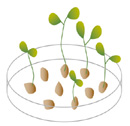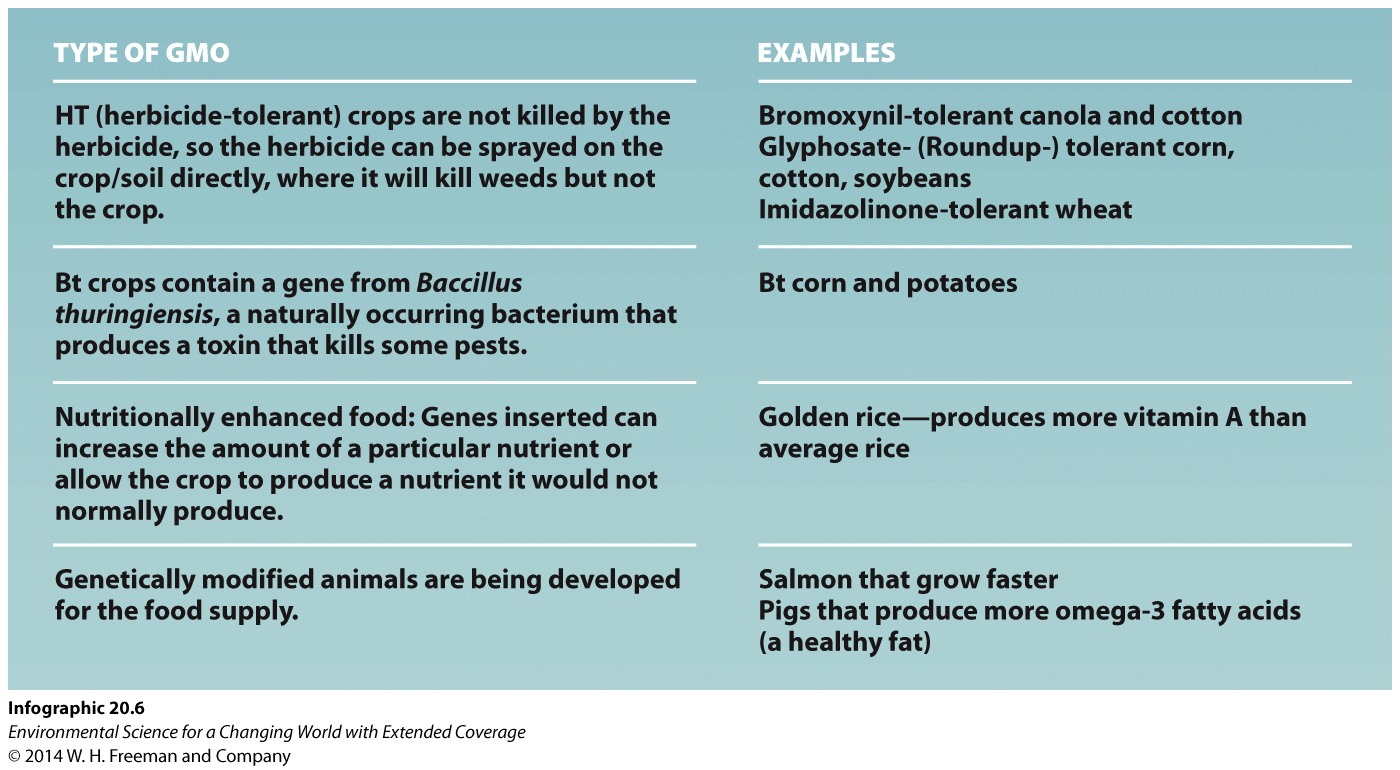
Chapter 20. Chapter 20: Feeding the World - A Gene Revolution
What is the focus of the next Green Revolution...?

Guiding Question 20.4
What is the focus of the next "Green Revolution" and how do researchers get new, desired traits into crops?
Why You Should Care
Advances in molecular biology and genetic engineering have brought modern agriculture into a brave new world. Genetically Modified Organisms (GMOs) are arguably the centerpiece of the next ‘green revolution’ in farming methods. Genetic modification of domesticated plants and animals has been around for millennia in the form of selective breeding and grafting, but the technology now exists to insert into crop or livestock genes that did not evolve in their species. There are several ways to do this, including simply ‘shooting’ the genes into cells and using an intermediate carrier, such as a bacterium or virus to deliver the gene into cells. So far, no genetically modified animal has been approved for consumption. Most of the modifications to crops center around increasing harvests, by reducing the labor and chemicals needed to grow them: genes to make them resistant to herbicides (weed killers) or produce their own pesticides. Some crops have been further modified to make them easier to ship, such as slowing their ripening.
Test Your Vocabulary
Choose the correct term from the drop-down for each of the following definitions:
1. Organisms that have had their genetic information altered to give them desirable characteristics such as pest or drought resistance: .
2. An organism that contains genes from another species is a .
3. The was a change in agricultural practices that focused on the production of genetically modified organisms (GMOs) to increase crop productivity or create new varieties of crops.
1.
Which of the following about GMOs is FALSE?
| A. |
| B. |
| C. |
| D. |
2.
Bacillus thuringiensis is _________________. (check all that apply)
a. A bacterium
b. The source of the pesticide Bt
c. Used to transfer new genes into plant cells
d. Harmful to most plants
3.
Plasmids are _________________. (check all that apply)
a. Organelles based on chloroplasts
b. Small circular pieces of DNA
c. Naturally found in bacteria
d. Used to transfer new genes into plant cells
4.
After a new gene is inserted into plant cells, the first plants with the gene are grown from ____________.
| A. |
| B. |
| C. |
| D. |
5.
Golden rice is a variety of GMO rice with genes from different organisms (including daffodils and corn) added to make it produce vitamin A in the edible part of the rice. It was developed because most areas of the world with widespread vitamin-A deficiencies (which can cause blindness in children) also consume most of their dietary calories as rice. Choose the correct order of steps for creating golden rice.
| Image | Step |
|---|---|

|
|

|
|

|
|

|
|

|
|

|
|

|

6.
Which of the following statements is false?
| A. |
| B. |
| C. |
| D. |
7.
The Bt toxin _________.
| A. |
| B. |
| C. |
| D. |
8.
An example of food engineered to be healthier is _________.
| A. |
| B. |
| C. |
| D. |
9.
Submergence resistance in rice has been promoted by some prominent figures as __________.
| A. |
| B. |
| C. |
| D. |
10.
Thought Question: No genetically modified animal has yet been approved for consumption in the U.S. Would you be concerned about eating a GM salmon or a piece of GM pork? Why?
11.
Thought Question: What are four reasons that organisms have been genetically modified?
2) to produce their own pesticides
3) to be more nutritious
4) to grow faster
Another example is fruit engineered to ripen more slowly.
Activity results are being submitted...